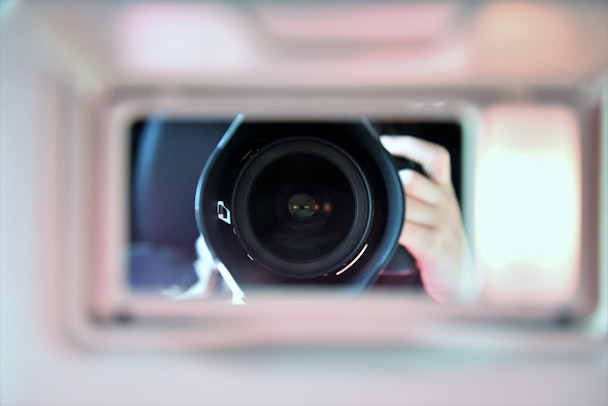Reinventing brand activations: how to combine marketing theory and interaction design
Designing a memorable experience isn’t easy. But Joe Rangecroft argues that there’s plenty of inspiration out there – from interaction design know-how to high-brow aesthetic theory – for brands looking to stand out.

What connects John Berger's Ways of Seeing with experiential marketing? / Abigail Low via Unsplash
As we progress further into a new realm of experiential marketing, our output will be increasingly geared towards conveying brands to consumers through haptic, emotional qualities.
When the lasting impression on a consumer from a physical interaction with a brand depends so much on the tactile sensations experienced within it, we need to adopt a new philosophy and workflow that considers these physical intricacies – feel, scent, sound, look and more.
Let’s get physical
Very often, audio-visual equipment and props are used almost arbitrarily to form an activation, ignoring the intricacies of how these elements interrelate. But those intricacies are what will guide the user down certain lanes of interaction, guiding their engagement.
If a brand activation is constructed in a high-ceiling, wide open space, participants will feel very aware of their own presence in the space. This creates a tendency to feel more self-conscious, and people may explore the space’s content less. Activations in loud, echoey spaces will also make people more aware of their own voices, decreasing the opportunity for meaningful discussion.
A brand experience involving live music, lighting and visuals that are visually unique and act in time with sound will create an immersive environment that pulls the participant further into a brand’s marketing aims. If this same activation were more interactive, where crowd reaction dictated the nature of the lighting or sound, the audience would be immersed even more.
It is unfortunately true that gen Z attention spans can be short, and using resources like this (lighting, projections, props, structures, etc) that capture and prolong the attention of a curious mind should be an aim if you want to engage them.
Advertisement
The symbiotic brand environment
When we design content to be experienced in a three-dimensional space, it exists in tandem with it. Everything around it exerts an equally persuasive effect on the user. No longer are we just creating content like flyers, billboards, videos, or products whose power exists only within their own dimensions. These mediums may be included, but the complete activation has a symbiotic relationship with its environment. A compromise with the space is made in the content’s effect on the user.
Successful activations recognize that we live in a world continuously in flux, where consumers make choices based on emotional wants, not just functional needs.
As the saying goes, first it was about selling what a car is, then what it does, then what it’s best at, and now how it will make you feel. We are in the final frontier of this development. An activation’s duties is no longer to inform, but to evoke a feeling. To achieve that, more artistic and conceptual resources must be considered, stepping away from workflows that focus solely on presenting information.
All the different tools, technology and set pieces we use to create activations have their own unique effects on participants that must be accounted for, and a workflow that considers theory on these effects will heighten its ability to immerse its audience. Instead of placing product in front of users and hoping they will engage with it, we can use interaction design principles to construct an environment that facilitates optimum engagement.
Advertisement
Interaction design and aesthetics
The digital tools we use have come to characterize our design processes, and allow very accessible and instantaneous means of production and research. We’ve become reliant on immediate and visual forms of inspiration. Of course, research on aesthetics is essential in ideation for an activation, but first researching theoretical perspectives on our cultural landscape like John Berger’s Ways of Seeing would provide a far deeper understanding of our context and thus our aims.
Consulting resources like libraries or book collections that have had a chance to age is important in gaining a design perspective. This has been somewhat sidelined in recent times. The fact that our industry is filled with very similar activation offerings visualizes our new digital research preferences.
Granted, it's necessary to be aware of what competitors are producing, but an agency that creates content in the style of modern trends will only be seen as current, not innovative. Innovation comes from an understanding of our larger cultural framework and zeitgeist, and by comparing current trends to past ones we can draw comparisons between the trajectories and estimate where we can progress to. Arguably, this viewpoint on innovation can only be developed through the lens of theory.
Suggested newsletters for you
Activations that use innovative, interactive tools and technology are not commonplace, but this echoes the same dynamic that our industry had with sustainability or corporate responsibility a decade ago: it seems an unnecessary development until (practically overnight) it becomes obvious that this is an essential new facet. What appears obvious but hasn’t yet been put into practice is a very good indicator of what will evolve next.
So far, we have mostly seen all-encompassing branded environments created through virtual reality and other digitalized means. Although this seems to be investors’ preference, to me it rings a loud bell of ‘innovation for innovation’s sake’. Who actually wants virtual reality art galleries and parties? Not me, and not anyone I’ve spoken to.
This rise in digital activations will continue, but so will its counterpart: increased concentration on physical, interactive, memorable activations that create fulfilling experiences for audiences. It’s time we changed our workflows and give interaction design the attention it deserves.
Content by The Drum Network member:

Raptor Marketing
We are Raptor, the student marketing agency.
We’re a team of young, hungry student marketing specialists who help build lasting connections between students,...

